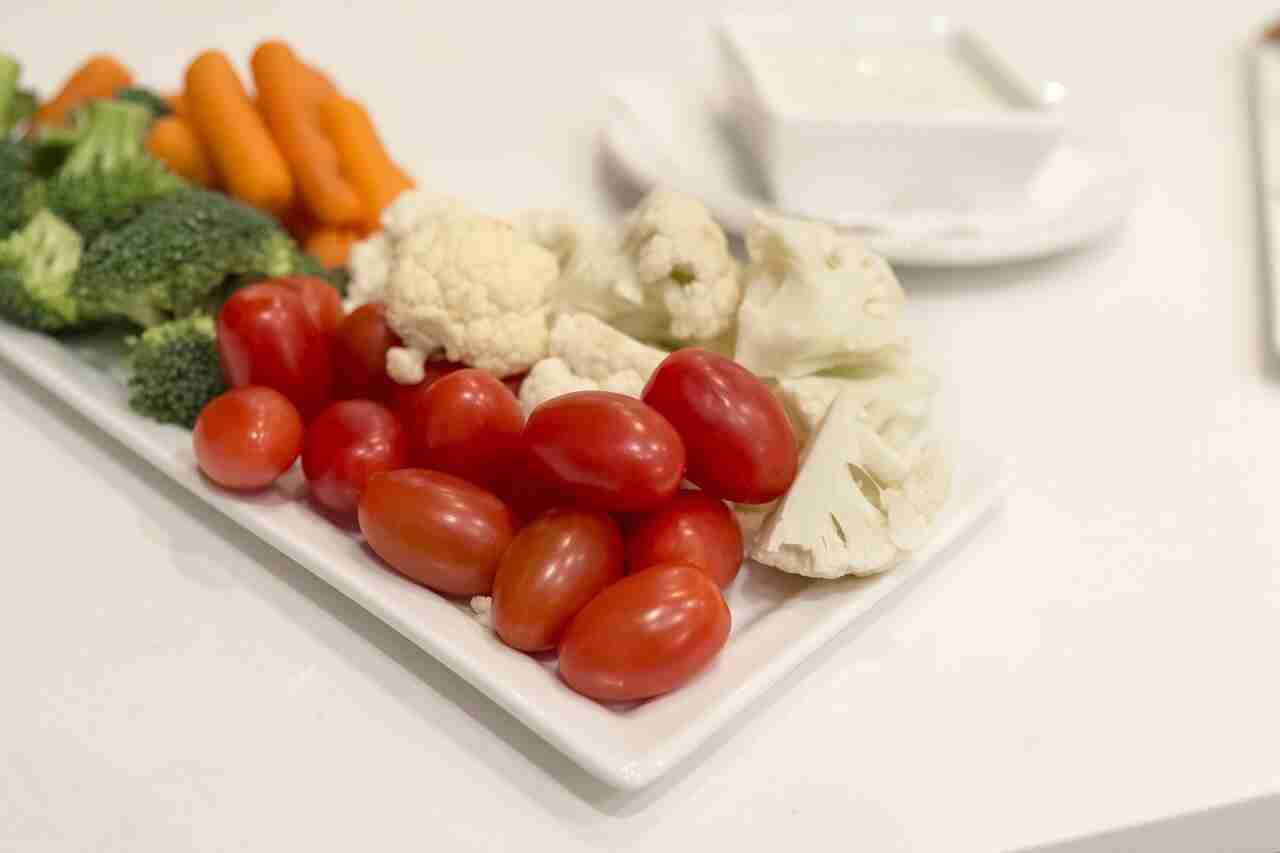A member in my Sweet Spot Kitchen program asked recently, “Can you suggest an alternative to ranch dressing for dipping vegetables?”
I can (below), but first, ranch dressing is better than you might think! If you have some in your kitchen, grab it and take a look. If you don’t, here’s a popular brand:

Check the list of ingredients
The ingredients are listed in order by weight. Focus on the first three. Like the Pareto (80/20) principle, where 80% of consequences come from 20% of causes, the first 3 ingredients will usually constitute most of what’s in the bottle.

Vegetable oil
First on this list is vegetable oil, which, in Canada, typically means the manufacturer is using a blend of different oils, or may switch between oils depending on availability and cost. The most common oils used under the “vegetable oil” label in Canada include:
- Canola oil
- Soybean oil
- Sunflower oil
- Safflower oil
- Corn oil

In the US, the rules are similar, except that you might see slightly more specific information about the oils used, due to allergen labeling requirements.
Wait… seed oils!?
If you’ve read about nutrition online, you might recognize these as “seed oils” and have surely come across a YouTuber or TikToker, maybe even an MD, decrying them emphatically. Critics claim they’re inflammatory and therefore harmful to heart health.
The charge makes sense. Seed oils are rich in omega-6 polyunsaturated fats, particularly one (linoleic acid) that the body can convert into a building block for molecules that can promote inflammation (arachidonic acid).
But this science advisory from the American Heart Association (AHA) finds that we can also convert arachidonic acid into anti-inflammatory molecules, and on balance, omega-6 polyunsaturated fats, as in vegetable oils, have an anti-inflammatory effect.
This paper, which compiled the results of 30 randomized controlled studies, found that increasing linoleic intake doesn’t have a significant effect on inflammatory markers in the blood, except for one, “in subjects with a more profound increase” in it. (So maybe don’t drink vegetable oil.)
Seriously thought, I always like to look at the bottom line outcomes. What does the research show about actual health impacts of vegetable oils?
Substantial scientific evidence supports the role of (non-tropical) vegetable oils in promoting heart health!
How? Those polyunsaturated fats help lower harmful LDL-cholesterol, reducing the risk of coronary heart disease. A “Presidential Advisory” from AHA concluded that “randomized controlled trials that lowered intake of dietary saturated fat and replaced it with polyunsaturated vegetable oil reduced cardiovascular disease by about 30%.”
And it’s not just AHA. The World Health Organization and Canada’s Heart & Stroke Foundation also advise eating foods rich in unsaturated instead of saturated fat.
Population studies support seed oil safety and benefits. Long-term studies like the Nurses’ Health Study found lower heart disease risk with higher polyunsaturated fat intake. When researchers looked at linoleic acid levels in over 68,000 people, they found that the folks with more of it had fewer cardiovascular events! There were similarly positive outcomes for type 2 diabetes, cancer, and early death.
Go ranch dressing!
But what about the sugar and salt?
Next on the list you might see ingredients like sugar and salt, so take a look at the Nutrition Facts table to see how much.

First, remember that this table describes nutrients in one tablespoon of ranch dressing. Is that how much you’ll eat in a go? Say you’re going to have more like two tablespoons – make sure to double everything when you’re assessing this.
So you’ll get 2 grams of sugar. That’s pretty small relative to the 25-50 grams or so (or less) you might be aiming for each day. Sugar is in many foods, but honestly, the biggest concern sugar-wise is sweetened beverages like soda/pop, sweetened iced tea, coffee drinks, etc. Two grams in ranch + veggies is the least of our sugar problems.
The salt is more troubling, amounting to 250mg in two tablespoons, or 10% of the Daily Value (DV), the maximum amount of sodium recommended to minimize the risk of chronic diseases. (That’s the percent number you see on the label, 5% in this case, doubled because we’re having two tablespoons.) 10% from a snack isn’t ideal, if a lot of other sodium-containing foods slip in throughout the day.
But if you make most of your food at home, and you’re confident that your use of sodium-rich foods is relatively low, you can make that 10% fit.
What about the rest of the ingredients?
It is an awfully long list, with many ingredients that might fail the “can’t pronounce it –> don’t eat it,” rule for you. But I don’t agree with that rule. After all, you might not be sure how to pronounce alpha-tocopherol, but that’s just vitamin E, often added to foods as an antioxidant to prevent rancidity and extend shelf life.
We could go through them one by one, but honestly, there’s nothing in there I’d be worried about.
It’s so processed!
We’ve been hearing a lot lately about the association between so-called ultraprocessed foods and worse health outcomes, but before you throw out every processed food product in your kitchen, ask these two questions:
- Did the processing add something that would adversely affect my health? For example, did they add a lot of sodium or processed meat, like you might find on a meat-lovers frozen pizza? Did they add a lot of sugar, as in cookies?
- Did they remove something that would benefit my health? A common one is the use of enriched wheat flour, where they’ve removed the bran and the germ from whole wheat, making the food easier to overeat.
The answers would be no for the ranch dressing, but if you’re still leery…
You can make your own ranch dressing!
If you love ranch but not the extra sodium and additives in the bottle, it’s pretty quick to make. As with most things homemade, homemade salad dressings are lower in sodium, especially this low-sodium ranch dressing I found. I haven’t tried it, but it uses several dried herbs and other ingredients for flavour, so it might be worth a try.
(Let us know in the Facebook group if you try it!)
And then there are the veggies!

The other reason I don’t worry if people like ranch with veggies is that is helps them get more veggies! That’s incredibly important for cardiovascular and general health. In fact, both carrots and celery are good sources of potassium, which acts to help lower blood pressure, countering the sodium in the bottled dressing!
Alternatives to ranch
For variety, try dipping your raw veggies in:
- Hummus – Again, the storebought hummus will likely have more sodium than homemade. Two tablespoons of this traditional hummus has just 4% DV of sodium, plus 7% DV fibre and 2 grams of protein! Just like the ranch, it will also give you polyunsaturated fats.
- Basic tahini sauce – It’s like hummus without the chickpeas! Very quick and easy to make. I learned about it from Bonnie Stern, the prolific Canadian cookbook author. You can find the recipe in her latest book, Don’t Worry, Just Cook, but it’s also part of this recipe she shared with a newspaper.
- Tzatziki – Cool and creamy – yogurt with cucumber, garlic, and dill. With 2% DV of sodium, even this store-bought brand is fine, nutritionally. Making it yourself would be more work (you’ll need to grate zucchini), but the taste is probably exponentially better.
I hope this gives you some fresh ideas! Honestly, if you’re nibbling on raw veggies, it’s hard to go too far wrong with the condiment.

Bottom line
To co-opt Bonnie Stern’s title, “Don’t worry, just eat!” Honestly, the fuss about vegetable and other seed oils has been counterproductive. Choose whichever of these sounds good to you, watch the sodium, and go on with your day.
If you need more heart-healthy snack ideas, you can download a list of my good ones here.
And if you have other suggestions, or comments about making versus one of these, please jump into our Facebook group and join the conversation. New members are always welcome.
As always, this post is based on my expertise and not any financial relationships I have with food companies – I have none. I don’t do sponsored posts, so you can be confident in my independent advice.









